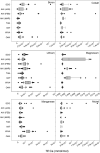Combining genotypic and phenotypic variation in a geospatial framework to identify sources of mussels in northern New Zealand
- PMID: 33854121
- PMCID: PMC8046997
- DOI: 10.1038/s41598-021-87326-4
Combining genotypic and phenotypic variation in a geospatial framework to identify sources of mussels in northern New Zealand
Abstract
The New Zealand green-lipped mussel aquaculture industry is largely dependent on the supply of young mussels that wash up on Ninety Mile Beach (so-called Kaitaia spat), which are collected and trucked to aquaculture farms. The locations of source populations of Kaitaia spat are unknown and this lack of knowledge represents a major problem because spat supply may be irregular. We combined genotypic (microsatellite) and phenotypic (shell geochemistry) data in a geospatial framework to determine if this new approach can help identify source populations of mussels collected from two spat-collecting and four non-spat-collecting sites further south. Genetic analyses resolved differentiated clusters (mostly three clusters), but no obvious source populations. Shell geochemistry analyses resolved six differentiated clusters, as did the combined genotypic and phenotypic data. Analyses revealed high levels of spatial and temporal variability in the geochemistry signal. Whilst we have not been able to identify the source site(s) of Kaitaia spat our analyses indicate that geospatial testing using combined genotypic and phenotypic data is a powerful approach. Next steps should employ analyses of single nucleotide polymorphism markers with shell geochemistry and in conjunction with high resolution physical oceanographic modelling to resolve the longstanding question of the origin of Kaitaia spat.
Conflict of interest statement
The authors declare no competing interests.
Figures




Similar articles
-
Identifying the source populations supplying a vital economic marine species for the New Zealand aquaculture industry.Sci Rep. 2023 Jun 8;13(1):9344. doi: 10.1038/s41598-023-36224-y. Sci Rep. 2023. PMID: 37291180 Free PMC article.
-
Efficiency of blue mussel (Mytilus edulis) spat collectors in highly dynamic tidal environments of the Lower Saxonian coast (southern North Sea).Biomol Eng. 2003 Jul;20(4-6):407-11. doi: 10.1016/s1389-0344(03)00064-9. Biomol Eng. 2003. PMID: 12919826
-
[Pearl mussels of the genus Dahurinaia (Bivalvia, Margaritiferidae): differently sized groups of Margaritifera dahurica Middendorff, 1850].Izv Akad Nauk Ser Biol. 2014 Sep-Oct;(5):481-91. Izv Akad Nauk Ser Biol. 2014. PMID: 25720287 Russian.
-
Mussels as a model system for integrative ecomechanics.Ann Rev Mar Sci. 2015;7:443-69. doi: 10.1146/annurev-marine-010213-135049. Epub 2014 Aug 25. Ann Rev Mar Sci. 2015. PMID: 25195867 Review.
-
Evo-devo of shell colour in gastropods and bivalves.Curr Opin Genet Dev. 2021 Aug;69:1-5. doi: 10.1016/j.gde.2020.11.009. Epub 2020 Dec 31. Curr Opin Genet Dev. 2021. PMID: 33388521 Review.
Cited by
-
Identifying the source populations supplying a vital economic marine species for the New Zealand aquaculture industry.Sci Rep. 2023 Jun 8;13(1):9344. doi: 10.1038/s41598-023-36224-y. Sci Rep. 2023. PMID: 37291180 Free PMC article.
-
Genetic stock identification in Perna viridis (Linnaeus1758) from the Indian Peninsula by using microsatellite markers.Mol Biol Rep. 2022 Apr;49(4):3357-3363. doi: 10.1007/s11033-022-07178-7. Epub 2022 Feb 6. Mol Biol Rep. 2022. PMID: 35124794
References
-
- Pineda J, Hare J, Sponaugle S. Larval transport and dispersal in the Coastal Ocean and consequences for population connectivity. Oceanography. 2007;20:22–39. doi: 10.5670/oceanog.2007.27. - DOI
-
- Apte S, Star B, Gardner JPA. A comparison of genetic diversity between cultured and wild populations, and a test of genetic introgression in the New Zealand greenshell mussel, Perna canaliculus (Gmelin 1791) Aquaculture. 2003;219:193–220. doi: 10.1016/S0044-8486(03)00003-6. - DOI
Publication types
MeSH terms
LinkOut - more resources
Full Text Sources
Other Literature Sources

